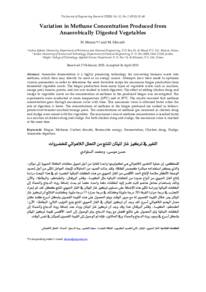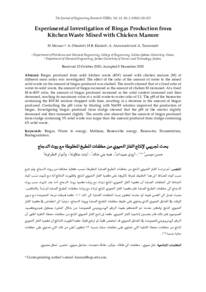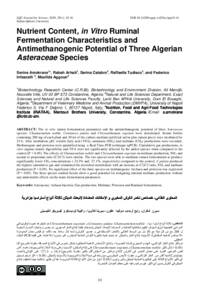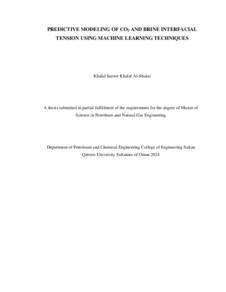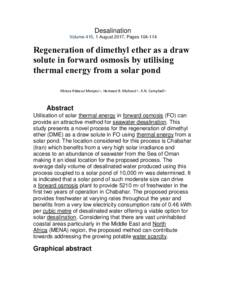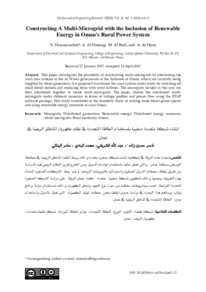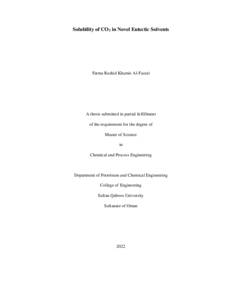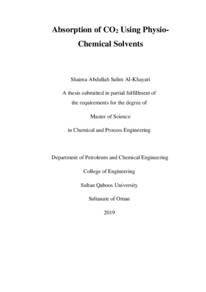Document
Variation in methane concentration produced from anaerobically digested vegetables.
Contributors
Silwadi, M., Author
Publisher
Sultan Qaboos University.
Gregorian
2015
Language
English
Subject
English abstract
Anaerobic fermentation is a highly promising technology for converting biomass waste into methane, which then may directly be used as an energy source. Attempts have been made to optimize various parameters in order to determine the most favorable recipe for maximum biogas production from fermented vegetable waste. The biogas production from many types of vegetable waste such as zucchini, orange peel, tomato, potato, and rice was studied in batch digesters. The effect of adding chicken dung and sludge to vegetable waste on the concentration of methane in the produced biogas was investigated. The experiments were conducted at room temperature (20°C) and at 35°C. The results revealed that methane concentration goes through maximum value with time. This maximum value is obtained faster when the rate of digestion is faster. The concentrations of methane in the biogas produced are ranked as follows: potato>rice>tomato>zucchini>orange peels. The concentrations of methane gas increased as chicken dung and sludge were mixed with the vegetables. The maximum value of methane concentration is reached faster in a mixture of chicken dung and sludge. For both chicken dung and sludge, the maximum value is reached at the same time.
Member of
ISSN
1726-6742
Resource URL
Citation
Mousa, H., & Silwadi, M. (2015). Variation in methane concentration produced from anaerobically digested vegetables. The Journal of Engineering Research, 12 (2), 32-40.
Arabic abstract
إن عملية التخمير اللاهوائي هي تكنولوجيا واعدة للغاية من أجل تحويل مخلفات الكتلة الحيوية إلى ميثان، والذي يمكن استخدامه مباشرة كمصدر للطاقة. ولقد بذلت العديد من المحاولات لإيجاد العوامل المثلى من أجل تحديد الوصفة الأكثر ملاءمة لإنتاج الحد الأقصى من الغاز الحيوي من هذه المخلفات النباتية المخمرة. تم في هذا البحث دراسة إنتاج الغاز الحيوي من أنواع عديدة من المخلفات النباتية مثل الكوسا، وقشر البرتقال، والطماطم، والبطاطا، والأرز وذلك باستخدام مفاعل هاضم ثابت تقدم إليه المخلفات دفعة واحدة. كما تم بحث إضافة روث الدجاج والحمأة إلى المخلفات النباتية ودراسة تأثير هذه الإضافة على مستوى تركيز غاز الميثان في الغاز الحيوي المنتج ككل. لقد تم إجراء التجارب في درجة حرارة الغرفة (20 درجة مئوية ) وكذلك في درجة حرارة 35 درجة مئوية. وكشفت النتائج أن تركيز غاز الميثان يمر خلال القيمة القصوى له مع مرور الوقت. ويتم الحصول على هذه القيمة القصوى بشكل أسرع كلما كان معدل الهضم اللاهوائي أسرع. لقد وجد أن تركيز الميثان في الغاز الحيوي المنتج يتبع الترتيب التالي : البطاطا، الأرز، الطماطم، الكوسا، وقشر البرتقال. هذا وقد وجد أن تركيز غاز الميثان يزداد عند إضافة روث الدجاج والحمأة إلى المخلفات النباتية وتم الحصول على نتائج أفضل مع روث الدجاج. وتم الوصول إلى الحد الأقصى لقيمة تركيز الميثان بشكل أسرع في وجود روث الدجاج والحمأة. وفي الحالتين، فإنه تم الوصول إلى القيمة القصوى للميثان في نفس الوقت.
Category
Journal articles

